Like many others, we eagerly awaited the new Dexcom G7 continuous glucose monitoring (CGM) following its release in the pipeline of new medical devices after its FDA approval. The device is meant to be more accurate than the previous Dexcom G6 model, while potentially being cheaper and easier to use.
Once it was released, we had to wait several months for Tandem to integrate the Dexcom G7 into its technology, Tandem Control IQ insulin pump.
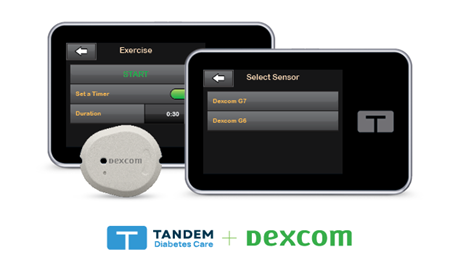
Finally, they integrated these two cutting-edge technologies on December 13, 2023. In January, we received approval from the insurance company, and here we are!
This article reviews our experience upgrading from the pairing of the Dexcom G6 + Tandem Control IQ to the pairing of the Dexcom G7 and Tandem Control IQ. My 8-year-old daughter uses the G7 now in concert with her Tandem insulin pump for her Type 1 diabetes and is the subject of this review.
While this Dexcom G7 review focuses on using the device for a child, similar principles apply for other age groups as well. Indeed, some of the challenges we faced are directly relevant for anyone supporting a senior with diabetes.
Making the Transition
We received approval from my daughter’s doctor and insurance insurance provider for the Dexcom G7. However, we decided to finish with the several Dexcom G6s we still had in the cabinet before getting started with the G7.
Many families may have to take a similar approach, as it’s such a waste to simply dispose of supplies that you’ve already paid for.
The Financial Side of Things
I won’t go into costs too much, as I know this will vary drastically for everyone depending on your state, insurer, country, and financial situation.
I can tell you what we pay though.
For 90 days’ worth of Dexcom G7s, we paid $200. Once we hit our deductible mid-year, that cost will go down to zero dollars. For comparison, the G6s were $255 for the same 90-day supply), around this time last year, not including the Transmitter. This aligns with what I’ve read elsewhere and Dexcom’s goal of reducing production and supply costs by combining the Sensor and Transmitter.
So, for us at least, the Dexcom G7 works out to be a little less expensive than the Dexcom G6. That’s great for technology that’s also meant to work better.
Practical Differences
As you know, the Transmitter lasts about 90 days, while each Sensor in the G6 lasts 10 days. We had three more G6s but decided to continue with only two since the transmitter would expire before getting three more sensors in. That’s one hassle we don’t have to think about anymore.
The Dexcom G7 is now ‘all in one’ and has the Sensor and Transmitter in a single device. No more worrying about lining up dates between your Transmitter replacement date and your Sensor change to avoid losing days on your device.
Initial Setup and Software Installation
One of the first steps is to update the software on the Tandem App. You only need to do this at setup, and only once in a while thereafter. On the Tandem pump screen, under CGM in Option, you can select between the G6 and G7 from the Tandem pump if you ever need to revert to using the G6 by selecting ‘Change Sensor Type.’
You must put some muscle into removing the lid like you’re opening a tight jar, and when inserting the Sensor, you’ll need to press hard against the skin to trigger the slingshot, snap-on motion. I was initially a bit timid, thinking I was hurting her arm. My daughter took it like a champ and described it as even less noticeable than the G6.
You can take your Smartphone to scan the barcode on the device or enter the 4-digit number directly on her pump. You can STOP and START new sensors on the App and directly on the Tandem pump. The App then walks you screen-by-screen on each step.
The directions were truly 5-star and made the process very easy.
Using the Dexcom G7 and Tandem Control IQ Together
Do remember, though, that instructions for Dexcom G7 and Tandem Control IQ are still different. You need to enter the Sensor numbers on both the G7 app and the Tandem pump.
In fact, on our first sensor, we noticed our daughter wasn’t getting any basal insulin for a few hours because the pump was not reacting to any Dexcom readings until we entered her Sensor ID onto her pump. So, it is not enough to just enter the Sensor ID onto the Dexcom G7 app. Lesson learned.
Your kid may want to run off, but make sure they stay within range for the Sensor on their body and Tandem app to connect with the G7 App on the smartphone so you get proper updates.
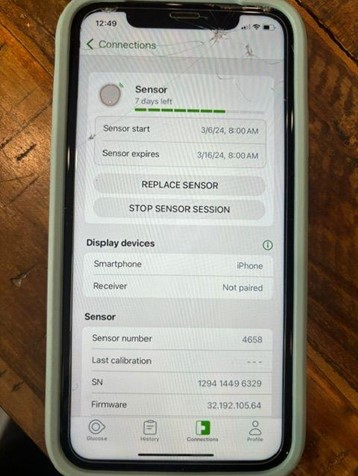
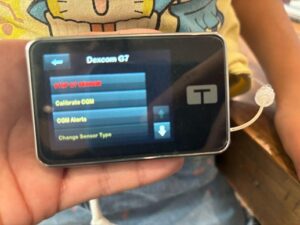
Easy and Painless Insertion
My daughter said she didn’t feel the Sensor insertion whatsoever. Of the 10 we’ve used thus far, she’s only complained about pain on one of them. The Sensor is the size of a quarter, much smaller and lighter than the previous version. It syncs in 30 minutes, and you can put a new one on while the old one still has a reading of what it is. We haven’t experienced this part yet, as all of her Sensors have had issues and have never lasted the full 10 days. More about that below.
The New Look and Feel for the Dexcom G7 App
The Dexcom G7 app includes a few upgrades and appears more user-friendly and intuitive than the G6. Be sure to update the OS (Operating System) on your Smartphone before downloading the Dexcom G7 app. This way everything will work smoothly.
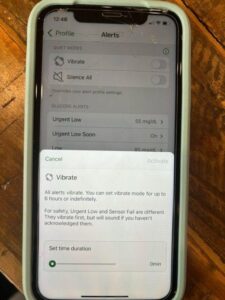

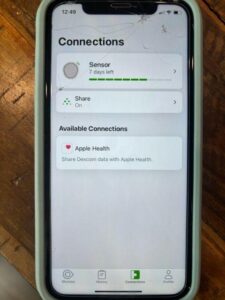
There are many similar features between the new and old apps, except the G7 app delivers an overall better user experience and navigation.
Percent Time in Range
A new perk of the G7 App is that it estimates your percent time in range and appears to have merged with Dexcom Clarity to give you a glimpse of your diabetes control through charts selected over various time periods.
Previously, I had to rely on viewing this range on the Tandem app to get an idea of how closely we were keeping my daughter in the desired range.
Customizable Alerts
Much like the G6 App, the new App provides customizable alerts and alarms for high and low glucose levels to help you assess your overall level of control over your diabetes. We also updated the Share settings and sent off an invite to her school’s Health Assistant the night before the school day.
A note to parents or caregivers: you don’t need to download a new Dexcom Follow App. You can use the same one – simply remove the old connection from your child or loved one’s Dexcom G6 app, send yourselves a new invite from the G7, and then accept the invite.
Silencing Alarms
One new component on the G7 App is the ‘Vibrate’ and ‘Silence All’ toggle buttons, which allow you to quickly silence all alarms in one shot. This feature is perfect for those moments at the movie theatre, church, or school performance.
Syncing Dexcom G7 App to the Apple Watch
Now that our kiddo is getting older and becoming slightly less destructive, we wanted to explore the potential benefit of having her use an older Apple Watch as another place for her to quickly view her numbers.
An Apple Watch is potentially the most effective approach, as her teachers hold onto her phone at school and pass it around like a baton between classes. Her blood glucose levels are also visible on her Tandem pump, which she wears inside a belt around her waist. The challenge is that her clothes sometimes cover these numbers.
Luckily, the G7 app is available for the watch and does the job excellently.
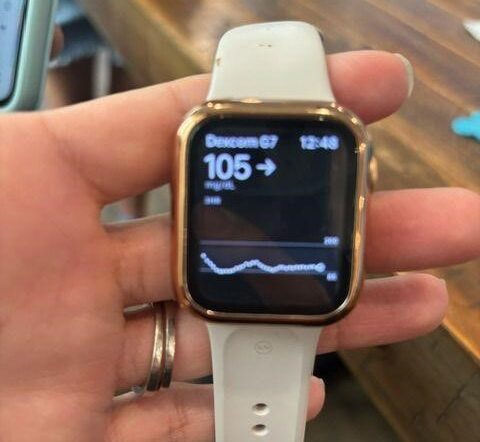
Potential Issues
It Won’t Stay On Longer than Five Days
Unfortunately, the first three sensors came off after only five days, half their 10-day expected lifespan. I used the single adhesive that Dexcom provided inside the same box as the Sensor at the point of insertion. In all three cases, the adhesive around the Sensor was not strong enough to hold it firmly against the back of my daughter’s arm. The fourth Sensor came off in the pool, likely from brushing up against the pool.
My guess is that its smaller size means there is less real estate to which it can adhere to her skin. This may become problematic as we get into the hot and steamy summer months with more water play and pool time.
Strangely, the second device came off during the middle of the night, even though it was not rubbing up against anything that would’ve stripped it off.
Absent Readings and Sensor Failures
With the fifth sensor, I had to replace it after experiencing a mix of inaccurate readings (where it inaccurately dropped to ‘urgent low’) and an extended period of no readings. As parents know, too much time without readings is non-negotiable when your kid has to be shuttled off to school or camp and won’t be in your direct care. I had to replace it two days prematurely.
After that, things just got worse. We had 3 back-to-back Sensors after fail within 24 hours.
The DexCom app would suddenly read ‘Insert New Sensor’ out of nowhere. Strangely, the Tandem pump would still be showing a blood glucose reading. On one, we couldn’t find the 4 digit code, and there was no way to bypass it. As any parent knows, it’s not enough to have the reading on the pump, we need the DexCom share feature in order for others to receive readings as well, so we had to replace it. The next one did the same thing while she was at school. I did have the code and relayed this to the Health Assistant, who said she got a message saying ‘You can only use the Sensor one time’ (something along those lines), so my husband had to run to school to replace it.
On the next Sensor, we received the same alert prompting us to Insert New Sensor. I contacted DexCom, who confirmed it was a Sensor failure. They gathered info and requested the Sensor for their research, and wanted details to submit to the FDA. They noted that it was best to enter the code onto the DexCom app first, wait until that synced, and then enter the code into the Tandem pump. Although it this case, it sounded like the device was just no good. For those using both the DexCom and Tandem, you need to enter the 4 digit code on both, so that Tandem is picking up the DexCom readings and can activate the Control IQ so that insulin adjust according to her readings.
Possible Solutions
I will have to explore other adhesives online again, such as the Lexcam, which had proven helpful with the G6 during swim season or at the beach. Many similar companies have already updated their designs to fit the G7. This brand tended to work very well for my daughter to keep the G6 on.
Thankfully, Dexcom makes it relatively easy to submit requests for replacement. But this is already becoming a hassle, as I’ve needed to replace EVERY SINGLE ONE thus far.
The Dexcom falling off was something we dealt with more regularly when she was age 4 to 6, and we had gotten to the stage where she no longer required extra adhesives to keep it on at all.
We are still exploring solutions to this. It’s possible that she may do better without any adhesive. Having a poorly made adhesive whose edges lift up may just be creating an opportunity for it to snag against clothes or other items.
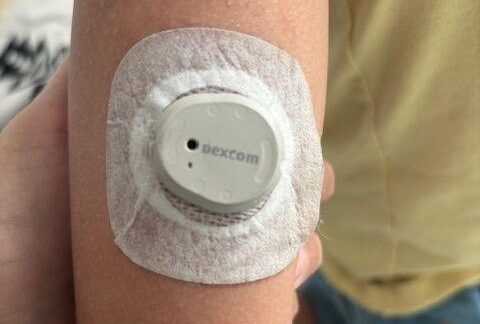
Concerns with Accuracy
For the Dexcom G6, a representative had once advised us only to calibrate when we found that it was off by 20% or more in either direction. That became our general rule.
With the Dexcom G7, we quickly learned that we would need to calibrate it more often than that until we trusted the reading.
On a few occasions, my daughter’s blood glucose levels were off by over 30 points. This is especially troubling for lows or during heavy exercise.
For instance, during gymnastics class, I could see that she was reading 113, but was surprised to see her walk out complaining that she was feeling dizzy and looking for her bag of fast-acting glucose. Usually, she feels that icky when she’s below 60. So we pricked her finger and verified against the AccuChek, and she was at 67.
On another occasion, her numbers kept dropping in the middle of the night. She was at 85, and mother’s instinct kicked in, so I decided to verify by pricking her finger with the AccCheck, and it showed that it was at a low of 52!
So parents, be cautious and on the alert. This may pose a challenge for night-time care when they are fast asleep and for kids who aren’t at the stage yet where they can sense their lows through other symptoms. The same may be true for aging parents with Type 1 diabetes, especially any that experience cognitive difficulties who can’t communicate when they feel off.
You can enter a calibration on the G7 app or on the Tandem pump. Unlike other components of the phone app, the specific place on the G7 is not intuitive. You’ll need to look under Log Blood Glucose and then select Use Calibration.
The last few Sensors have done a better job of coming very close to her true readings, often being only 2 to 3 points off. It feels like a crapshoot!
Final Thoughts
Overall, the pairing of Dexcom G7 and Tandem Control IQ insulin pump offers numerous advantages for kids with Type 1 diabetes and their parent caretakers. It’s also a fantastic combo for many other situations. The pair continues to be our preferred choice…for now. Her Endo really loves it too.
However, we’re finding that we’ll need to tread carefully during periods of heavy physical activity and nighttime watch and not get too comfortable with what we believe are in-range levels. As with all new technology, it may take time for these companies to iron out the kinks.
What is very concerning are the random Sensor Failures within 24 hours of insertion. Surely, DexCom has some quality control. If you haven’t already switched from Tandem-DexCom G6 to Tandem-DexCom G7, I wouldn’t be in much of a hurry. Let DexCom correct issues with this integration before upgrading.
We will continue to explore different arrangements to keep the G7 from falling off her arm, calibrate more often, and be aware of potential Sensor failures.
I’ve been open to the idea of the Tandem Mobi when that’s released this year, which is smaller than the t:slim and has no user interface, relying instead exclusively on the app. It would already be integrated with the DexCom G7 when it’s released as it uses the same technology as the Tandem t:slim X2. However, that may be too many changes all at once, and we may need to wait until DexCom and Insulet (the company that makes the Tandem products) improve their integration (or improve the G7), especially, as it would push us to always rely on the apps (the Tandem app and the DexCom app) for monitoring and adjustments. Insulet has some work to do to improve the reliability of their app too. Don’t get me started there!
We would love to hear about others’ experiences thus far and any workaround that you’ve had success with.
Feeling Overwhelmed?
Check out our Caregiving Consulting service for personalized support and guidance.

Leave a Reply